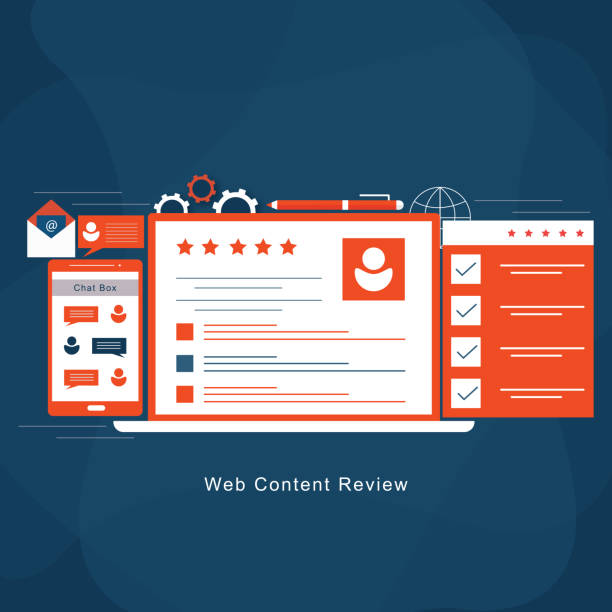An Introduction to Responsive Web Design and Its Importance in Today’s World

In today’s world, where users access the internet from various devices including mobile phones, tablets, laptops, and desktop monitors, #Responsive_Website_Design, or #Responsive_Design, is no longer a competitive advantage, but rather an unavoidable necessity for any online business.
This website design approach ensures that your website has a beautiful appearance and flawless performance regardless of the screen size or device type used.
The main goal of responsive web design is to provide a seamless and optimized User Experience (UX) for all visitors, leading to increased customer satisfaction and reduced bounce rates.
This importance is doubled when we consider that a significant portion of internet traffic currently comes from mobile devices.
Therefore, if your website cannot be displayed well on mobile, you will practically lose a large segment of your potential audience.
The history of responsive web design dates back to 2010 when Ethan Marcotte introduced this concept.
Since then, with the rapid advancement of mobile technology and the increasing variety of devices, this approach has become an industry standard.
Today, search engines like Google also give more importance in their rankings to websites that provide a better mobile experience.
This issue is not limited to the website’s appearance but also includes performance, loading speed, and ease of use across all platforms.
A seamless and desirable #User_Experience not only helps retain users but also leads to improved conversion rates and the achievement of your business goals.
In fact, responsive web design is a smart investment for the future of your online presence and allows you to compete confidently in the digital environment.
Are you tired of your e-commerce site having visitors but no sales? RasaWeb solves your core problem with professional e-commerce website design!
✅ Significant sales increase with targeted design
✅ Flawless user experience for your customers
⚡ Get a free consultation!
Basic Principles of Responsive Design: Media Queries and the Mobile-First Approach

At the heart of responsive web design lie three key principles: #Fluid_Grids, #Flexible_Images, and #Media_Queries.
Fluid grids use relative units (like percentages) for element widths instead of fixed pixels, allowing them to automatically adjust to screen size.
Flexible images, similarly, ensure that images never overflow their container and are always displayed correctly by using properties like max-width: 100%.
But the most powerful tool among these is Media Queries.
Media Queries allow developers to apply different CSS styles based on device characteristics (such as screen width, height, orientation, and resolution).
One of the crucial approaches in responsive design is “Mobile-First”.
This strategy means that the design and development process begins with the smallest screens (mobile) and then gradually expands to larger screens (tablet and desktop).
The reason for this approach is that designing for mobile requires focusing on essential content and optimal performance, as resources (screen space, bandwidth) are more limited.
By starting with mobile, designers are compelled to think about #Content_Prioritization and providing a simple and efficient user experience.
This method naturally leads to cleaner and more optimized code, which ultimately provides a better experience across all devices.
This concept is also directly related to Google’s mobile-first indexing capabilities, which highlights the strategic importance of this approach for #SEO as well.
By correctly implementing these principles, your website will not only look great on any device but will also be optimized for performance and SEO.
This comprehensive approach to responsive web design provides a solid foundation for your online success.
Common Tools and Frameworks for Implementing Responsive Design

To effectively implement responsive web design, developers utilize a set of tools and frameworks that facilitate and accelerate the process.
#CSS_Frameworks like Bootstrap and Foundation are among the most popular options.
These frameworks provide a collection of pre-built HTML, CSS, and JavaScript components, including responsive grid systems, navigation bars, forms, buttons, and many other elements.
Using these frameworks allows developers to build highly responsive websites at a very high speed, without needing to write code from scratch every time.
These tools also contribute to code standardization and improved maintainability.
In addition to frameworks, #CSS_Preprocessors like Sass and Less also play an important role in responsive design.
These preprocessors provide features such as variables, functions, and the ability to organize code modularly, which makes writing complex CSS much simpler and more efficient.
For example, you can define your breakpoints in variables and use them throughout your stylesheet, making future management and changes easier.
Browser Developer Tools in browsers like Chrome and Firefox are also essential for testing and debugging responsive web design.
These tools allow developers to simulate the website on different screen sizes and identify and resolve layout and performance issues.
The correct use of these tools ensures the optimization and acceleration of the development process for responsive websites.
Ultimately, the choice of appropriate tools depends on project complexity, development team preferences, and timeline.
Below is a table comparing some popular frameworks in responsive design:
| Framework Name | Key Features | Advantages | Disadvantages |
|---|---|---|---|
| Bootstrap | Strong grid system, diverse UI components, built-in JavaScript | Large user community, comprehensive documentation, easy to start | Relatively large file size, similar designs |
| Foundation | Focus on Mobile-First, Flexbox, highly customizable | High flexibility, lighter than Bootstrap, suitable for complex projects | Slightly steeper learning curve |
| Bulma | CSS-only framework, Flexbox-based, modular | CSS-only, easy to learn, lightweight and fast | No built-in JavaScript components |
Optimizing User Experience (UX) in Responsive Websites

One of the most important goals of responsive web design is to provide a flawless User Experience (UX) on any device.
Simply being responsive does not mean an excellent user experience; rather, it must be ensured that the website remains functional, accessible, and appealing across different screen sizes.
To achieve this goal, several key aspects must be considered.
First, #Navigation_Design and menus.
On smaller screens, extensive desktop menus should be transformed into hamburger menus or similar options that occupy less space but still keep access to different parts of the site easy.
Also, the size of buttons and clickable elements (Touch Targets) should be such that they are easily tappable on touch devices to prevent unintended errors.
Second, readability and font sizes.
Content should be easily readable on any device; this means that font sizes should be adjusted to suit the screen size, and line and paragraph spacing should also be maintained to improve readability.
Third, #Image_and_Media_Optimization.
Heavy images can drastically reduce site loading speed, especially on mobile devices with slow internet connections.
Using optimized image formats (such as WebP), compressing images, and using srcset and sizes attributes in HTML to deliver images with appropriate resolution for each device are crucial.
Finally, Page Load Speed is a critical factor in user experience.
Responsive websites should be optimized to load as quickly as possible, as mobile users react negatively to slow pages and often abandon the site.
By considering these points, you will not only have a responsive website but also provide a truly pleasant and efficient experience for your users on any device.
Are you bothered by losing customers who visited your site to make a purchase?
RasaWeb is your specialized solution for having a successful online store.
✅ Significant increase in your online sales
✅ Building trust and professional branding with customers⚡ Get a free consultation from RasaWeb experts!
The Amazing Impact of Responsive Design on SEO and Search Engine Rankings

In the current digital age, no discussion about online success is complete without considering #Search_Engine_Optimization (SEO).
Responsive web design not only improves the user experience but also has a significant impact on your website’s ranking in Google and other search engine results.
Google has explicitly stated that it prefers websites with responsive design and considers this a ranking factor.
The reason is simple: Google wants to provide the best possible experience to its users, and this includes displaying websites that are correctly and optimally displayed on any device.
One of the most important reasons for the positive impact of responsive web design on SEO is Google’s Mobile-First Indexing.
Since 2018, Google has increasingly used the mobile version of websites for crawling and indexing content.
This means that if your site’s mobile version is not optimized or has less content than the desktop version, your ranking will be severely affected.
A website with responsive design, having a single URL and consistent content across all devices, simplifies the crawling and indexing process for Google.
This prevents duplicate content issues and improves the distribution of link value across different versions of the site.
Furthermore, factors such as #Page_Load_Speed and #Bounce_Rate_Reduction, which are directly influenced by responsive design, are also considered important SEO factors.
Slow websites drive users away, and this sends a negative signal to search engines.
With responsive web design and optimization of images and scripts, you can significantly improve your site’s loading speed.
As a result, users will have a better experience, spend more time on your site, and these factors indirectly help improve your ranking.
Therefore, investing in responsive web design is a direct investment in the future of your business’s SEO and online visibility.
Challenges and Solutions for Overcoming Common Problems in Responsive Web Design

Although responsive web design offers countless benefits, its implementation is not without #Challenges and #Complexities.
One of the most common problems is managing #High-Resolution_Images, which can lead to reduced site loading speed on mobile devices.
While flexible images are a basic principle of responsive design, this alone is not enough.
The solution to this problem is to use techniques such as “lazy loading” of images, using the <picture> tag or the srcset attribute within the <img> tag to provide different versions of the image based on screen size, and next-generation image formats like WebP, which have smaller file sizes.
Another challenge is managing #Complex_Navigation and #Large_Menus on smaller screens.
Desktop menus containing dozens of items become unusable on mobile.
The solution to this problem is to redesign menus for mobile, such as using slide-out hamburger menus, off-canvas menus, or tab-based navigation.
Also, #Website_Testability across various devices and browsers can be difficult.
Given the countless varieties of devices and browser versions, ensuring correct performance across all platforms is time-consuming.
Using browser emulators, real testing devices, and automated testing services (like BrowserStack) can be helpful in this regard.
Another common issue is maintaining site performance.
Sometimes, improper coding or excessive use of scripts can slow down the site.
Optimizing CSS and JavaScript code, compressing files, and using Content Delivery Networks (CDNs) are effective solutions for overcoming these challenges in responsive web design.
Additionally, thought-provoking content in this section could include questions that challenge developers, such as “Is Mobile-First always the best approach?” or “How can we provide a consistent user experience despite device differences?” the answers to which require deeper analysis.
Reviewing Successful Responsive Design Examples and Learning from Them

To better understand how to successfully implement responsive web design, looking at real-world examples and #Case_Studies can be very inspiring.
Websites that are pioneers in this field not only appear beautifully and consistently across all devices but also provide a flawless user experience, leading to increased user engagement and satisfaction.
For instance, websites like The New York Times or Airbnb are outstanding examples of responsive design that have successfully optimized their rich content and complex user interfaces for any screen size.
These websites use flexible grid systems, optimized images, and intelligent navigation to ensure accessibility and readability on mobile and desktop.
One of the important lessons to learn from these successful examples is the #Importance_of_Simplicity and #Content_Prioritization.
On smaller devices, screen space is limited, so you must ensure that core content and important actions are easily visible and accessible.
This means removing unnecessary elements and focusing on what the user truly needs.
Furthermore, these websites effectively utilize modern CSS technologies like Flexbox and Grid Layout, which allow for the creation of more complex and responsive layouts.
These technologies give designers greater control over how elements are displayed on different screen sizes.
Analyzing these examples shows that a successful responsive website design is the result of meticulous planning, continuous testing, and a focus on user needs.
This is not just about adapting element sizes; it’s about redefining the user experience for each environment.
By emulating best practices and paying attention to detail, businesses can build websites that are not only visually appealing but also perform exceptionally and achieve their business goals.
This section could include a table with key responsive design features and how they are implemented in successful websites:
| Feature | Description | Implementation Method |
|---|---|---|
| Fluid Grid | Using percentages and relative units for element widths | CSS Flexbox, CSS Grid, Percentages |
| Flexible Images | Resizing images to fit the screen | max-width: 100%, <picture> tag, srcset attribute |
| Media Queries | Applying different styles based on device characteristics | @media screen and (...) rules in CSS |
| Optimized Mobile Navigation | Simplifying and transforming menus for small devices | Hamburger menu, Off-Canvas menu, Sticky navigation |
| Speed Optimization | Reducing page loading time on all devices | Compressed images, Lazy Loading, CDN, Minification |
The Future of Responsive Web Design and Predicting New Trends

As technology and user expectations evolve, #Responsive_Web_Design is also progressing.
The future of this field is full of #New_Trends that will help designers and developers create even better user experiences.
One of the most important developments is #CSS_Grid_Layout, which alongside Flexbox, offers more powerful tools for creating complex and fully responsive layouts.
CSS Grid provides two-dimensional control (both rows and columns) over layout, which was previously only possible with frameworks or JavaScript solutions.
This technology allows designers to create more dynamic and complex layouts that naturally adapt to different screen sizes.
The concept of “Container Queries” is also emerging.
While media queries operate based on the overall viewport size, Container Queries allow elements to react based on the size of their parent container.
This provides significantly more capabilities for modular and independent component design and reduces design complexity in large systems.
Also, #Responsive_Design_with_Dynamic_Content is another important trend.
In this approach, not only the page layout but also the displayed content changes based on the device, location, time of day, or even the user’s browsing history.
This leads to a much more personalized experience.
Furthermore, optimization for foldable and flexible devices, as well as Augmented Reality (AR) and Virtual Reality (VR), will gradually enter the realm of web design.
These emerging technologies create new challenges for how content is displayed and interacted with, requiring novel approaches in responsive design.
Finally, the focus on #Web_Performance and improving Google’s Core Web Vitals will remain a priority.
The future of responsive web design is full of opportunities for innovation and creating websites that are not only beautiful but also perform exceptionally in all conditions and delight users.
Businesses must constantly stay updated on this path.
Are you tired of losing business opportunities due to not having a professional corporate website?
RasaWeb, with professional corporate website design, helps you:
✅ Build a powerful and reliable image for your brand
✅ Convert website visitors into loyal customers
⚡ Get a free consultation now!
Key Tips for Choosing the Best Responsive Web Design Company

Choosing the right company for #Responsive_Website_Design is a critical decision that can significantly impact your business’s online success.
Given the increasing importance of responsiveness, it is essential to exercise due diligence when selecting your partner.
The first and most important tip is to review the company’s portfolio.
Ask them to show you their previous projects that feature responsive design.
These samples should be tested on various devices to ensure their correct functionality and optimal appearance.
Pay attention to whether their designs truly meet user needs on every platform or if they only change in appearance.
Second, evaluate the team’s #Technical_Expertise and #Up-to-Date_Knowledge.
Is the team familiar with the latest technologies and methods of responsive design? Are they knowledgeable about CSS Grid, Flexbox, image optimization, and loading speed? An expert company should be able to anticipate potential challenges and provide suitable solutions.
Third, inquire about the company’s approach to User Experience (UX) and SEO.
Responsive web design is not just about visual aesthetics; it should also help improve user experience and search engine rankings.
Choose a company that has a comprehensive approach to design and considers all these aspects.
They should be able to explain how their design will help increase your conversion rates and business visibility.
Fourth, consider #Post-Launch_Support and #Scalability.
Your website will require support, maintenance, and updates even after launch.
Ensure that the chosen company provides good after-sales services and delivers code that is scalable and maintainable.
Also, transparency in costs and contracts is very important.
All project details, timelines, and costs should be clearly stated in the contract.
By considering these points, you can find a suitable partner for responsive web design who will significantly help you achieve your online goals and be a profitable investment for the future of your business.
Why Responsive Design is No Longer an Option, but a Necessity?

In summarizing the topics discussed so far, one clear conclusion emerges: #Responsive_Web_Design is no longer a luxury option or a choice in the web world, but has become an absolute necessity for any business and individual aiming for a successful online presence.
The reasons for this are numerous and strong, rooted in fundamental changes in how users access the internet and the evolution of search engine standards.
With the increasing use of mobile devices for web browsing, ignoring the user experience on these platforms means losing a significant portion of your audience and business opportunities.
A website that does not display correctly on mobile not only disappoints users but also directs them towards competitors who have taken this aspect seriously.
Google’s mobile-first indexing alone is a compelling reason to invest in responsive web design.
Search engines aim to provide the best results to their users, and this means displaying websites that are optimized and efficient on every device.
Responsive websites offer many SEO benefits, including reduced bounce rate, increased user dwell time, and improved rankings in search results.
These factors directly impact your business’s visibility and the acquisition of new customers.
Furthermore, maintaining and managing a responsive website is much simpler and less costly than maintaining two separate versions (one for desktop and one for mobile).
This leads to #Reduced_Development_and_Management_Costs in the long run.
Finally, responsive web design allows you to provide a #Consistent_Brand and #Consistent_User_Experience across all devices.
This consistency increases user trust and strengthens your brand identity.
In a world where users expect uninterrupted and flawless access to information, a website that fails to meet this expectation will quickly become obsolete.
Therefore, investing in responsive web design is not just a technical measure but a strategic decision to ensure the survival and growth of your business in today’s and tomorrow’s digital ecosystem.
This is an investment in the future of your business.
Frequently Asked Questions
| Question | Answer |
|---|---|
| What is Responsive Web Design? | It is a method for designing and implementing websites that automatically adjusts the layout and content of the display based on the user’s device screen size (desktop, tablet, mobile, etc.) to be displayed in the best possible way. |
| Why is Responsive Design important? | With the increasing use of various devices to access the web, responsive site design improves user experience, reduces bounce rate, strengthens site SEO, and makes site management and maintenance easier (instead of having separate versions for mobile and desktop). |
| How does Responsive Design work? | This type of design uses techniques such as flexible grids and layouts (Flexbox, CSS Grid), flexible images and media, and most importantly, CSS Media Queries, to change page styles and layout based on screen characteristics (width, height, resolution, etc.). |
| What are the main tools for implementing Responsive Design? | The main tools include HTML5 (for content structure), CSS3 (especially Media Queries, Flexbox, Grid for responsive styling and layout), and sometimes JavaScript for more complex interactions. |
| What are the main advantages of using Responsive Design? | The main advantages include increased user accessibility (covering a wide range of devices), improved user experience, improved site ranking in search engines (especially Google), reduced development and maintenance costs, and increased visitor-to-customer conversion rates. |
And other advertising services by RasaWeb Advertising Agency
Smart UI/UX: An innovative platform for improving customer behavior analysis with attractive user interface design.
Smart Social Media: A blend of creativity and technology to increase click-through rates through precise audience targeting.
Smart Direct Marketing: An innovative platform for improving SEO ranking with marketing automation.
Smart Content Strategy: Revolutionize click-through rate increases with the help of attractive user interface design.
Smart Social Media: Designed for businesses looking to increase click-through rates through key page optimization.
And over hundreds of other services in the field of internet advertising, advertising consulting, and organizational solutions
Internet Advertising | Advertising Strategy | Advertorials
Resources
Advantages of Responsive Web Design
What is Responsive Web Design?
Responsive Site SEO
Digital Marketing Strategy
? Are you ready for your business to leap forward in the digital world? Rasaweb Afarin, a leading digital marketing agency, with expertise in SEO, Google Ads, and fast website design, paves your path to online success.
📍 Tehran, Mirdamad Street, next to Bank Markazi, Southern Kazeroon Alley, Ramin Alley, No. 6




